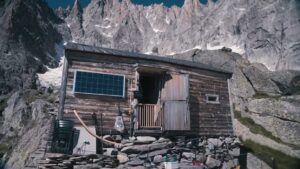The stimulations of Wet Lycra Nightmare are subtle.
At least, the ones you get from watching Jordan Cannon and Sam Stroh’s short film about their ascents of the route.
The climb itself would invigorate most.
The Leaning Tower is likely the steepest big wall in the United States. Over 300 meters of Yosemite granite yawn over the void, plunging from a crenelated ridgeline just above Bridalveil Falls. Wet Lycra Nightmare (5.13d) is the king line.
There’s a horizontal roof with heroic campus moves and “massive jugs,” as Stroh puts it, and plenty of sporty climbing. It also demands a taste of the twinkle-toes balancing Yosemite’s known for.

Photo: Screenshot
First and second ascents
But ever since “cowboy” Todd Skinner hung on for the first free ascent in 2004, the route has generally resisted further efforts.
Alex Honnold snagged the second ascent in 2015, but by the time Cannon and Stroh caught the Wet Lycra fever, only two other climbers had freed it.

Shirtless on a big wall. Who else? Photo: Screenshot
That didn’t stop Stroh. The youngster steals the show in the team’s Arcteryx-funded video by promptly claiming the fifth ascent. The performance becomes the precocious Stroh, who’s quickly earning favor among the likes of Honnold with his industrious approach to the sport.
Atop the tower, he celebrates with a familiar, casual snapping gesture.
“Always feels good to send,” he says simply.
This is the laid-back candor of the film in general. Cannon doesn’t sweat it when he doesn’t send. Instead, he reflects on the inspiration he takes from Wet Lycra Nightmare’s previous ascensionists and makes a plan that would make any self-care proponent beam.
“Reflect back on myself and, like, ok, how can I do this and what experience can I go for that’s going to make me happy?” He muses.
There’s not much else to say about the narrative. A climber contends with a route that challenges him, but he has no ego to check at the door, so fireworks aren’t on the itinerary. (Do watch for the scene where Cannon removes a piece of his shinbone after an awkward fall — it’s a welcome intrusion of the gnar.)

Photo: Screenshot
Focuses on the climb, not the climbers
Still, to the tastes of some viewers, the whole rig will come up a little short on enthusiasm. But maybe that’s not a bad thing. It makes room to let in the gold, gray, and green textures and giant distances that create Yosemite’s enduring beauty. And it places the focus on the climb itself, rather than the climbers’ subjective experience of it.

Photo: Screenshot
There was a time when most all climbing content would have belonged in seething, abrasive rags like Thrasher if it took place on skate ramps instead of rock walls. Now, even the reputationally acerbic Andrew Bisharat has gone sentimental.
It sure feels like the season has changed, and that Cannon and Stroh are proper envoys of the new generation. Confronted with this quiet chronicle as their offering, I can only do two things — check my own ego and get out of the way.






